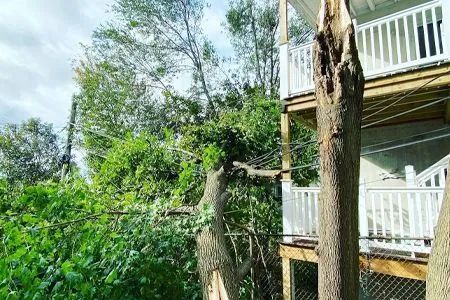4 Signs that a Tree Is at Heightened Risk of Crashing Down During a Storm

Storms can put tremendous stress on trees, especially those that are already weakened or unstable. High winds, heavy rain, and saturated soil can cause vulnerable trees to lose their balance or break apart, posing serious dangers to nearby homes, vehicles, and people. While healthy trees can often withstand harsh weather, certain warning signs indicate that a tree may be at an increased risk of falling. Identifying these signs early and taking action with the help of a professional arborist can help prevent costly damage and protect your safety. At JSK Tree Care, our local arborists are experts at identifying hazardous trees and safely removing them. Here are four warning signs that a tree may be more likely to crash down during a storm.
Significant Leaning or Shifting
A tree that is noticeably leaning, especially if the lean has become more pronounced over time, is a strong sign of instability. Leaning can occur due to weakened roots, soil erosion, or uneven weight distribution within the canopy. If the lean is sudden or accompanied by cracking in the soil around the base, it could mean the roots are failing, putting the tree at high risk of falling in strong winds.
Splits in the Trunk
Structural damage—such as large cracks, splits, or cavities in the trunk—can greatly reduce a tree’s ability to withstand the pressure of a storm. These weaknesses make it easier for the trunk to break apart under stress. Cracks near major branch unions or the base of the trunk are especially concerning and should be evaluated by a professional as soon as possible.
Dead/Decaying Wood
Dead branches or signs of internal decay—such as soft or hollow wood—indicate that parts of the tree are no longer structurally sound. Decay weakens the tree from the inside out, making it more prone to breaking during heavy winds. Fungal growth, such as mushrooms at the base, often signals root or trunk rot that can compromise stability.
Root Problems/Uplifted Soil
Healthy roots anchor a tree firmly in the ground. If you notice exposed roots, soil heaving, or cracks around the base, the tree’s root system may be failing. Storms with heavy rainfall can loosen already weakened roots, increasing the likelihood of the tree toppling over. Root issues are often hidden, so surface signs should never be ignored.
Tree Removal in Falmouth, MA
For
tree removal in Falmouth and the surrounding area, contact JSK Tree Care at
774-506-4655. Feel free to give us a call to request an arborist estimate in Falmouth!


